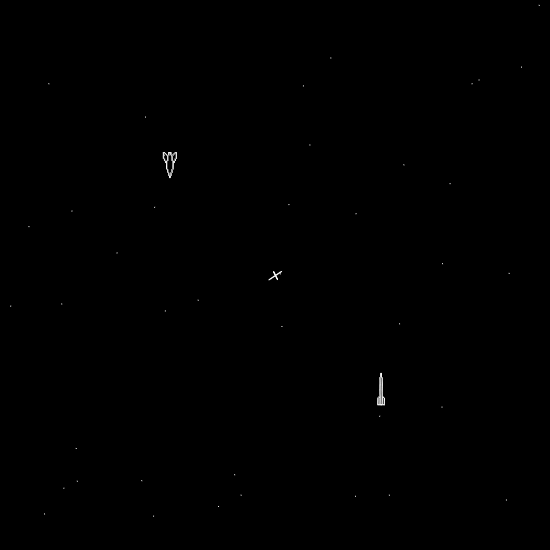Spacewar! - 1962
| Year: | 1962 |
| Original platform: | Digital Equipment Corp PDP-1 minicomputer |
| Brief description: | Space warfare simulation |
| Number of players: | 2 |
| Developers/contributors: | Steve Russell, Martin Graetz, Wayne Wiitanen, Alan Kotok, Dan Edwards, Peter Samson, Steve Piner, Robert A. Saunders. |
Although possibly the first multiplayer computer game, Spacewar! was not the first to exploit the graphics capabilities of a digital computer. One well-documented example is OXO, a game of Noughts and Crosses (or Tic-tac-toe, to give it its American name). OXO was developed by Alexander Douglas, a computer science professor at Cambridge University, in 1952.
Another example, Tennis for Two, was created by US physicist William Higginbotham at the Brookhaven National Laboratory in New York in 1958. These early games, however, used discrete analogue electronics to implement the game routines rather than software. Spacewar! is probably the earliest example, for which documentation still exists, of a graphical computer game implemented as a computer program.
The original concept for Spacewar! was the brainchild of Massachusetts Institute of Technology (MIT) student Steve Russell, and was apparently inspired by the work of the legendary science fiction author E.E. "Doc" Smith. Russell, together with several other students and MIT personnel, developed the program in order to demonstrate the graphics capabilities of the PDP-1.
Although Russell is often given credit for writing the program, it was essentially a team effort. The sine and cosine routines were contributed by Alan Kotok, who in turn obtained the routines from the Digital Equipment Corporation (DEC). DEC would later include the Spacewar! game when delivering new PDP-1 minicomputers to customers, both to showcase the machine's graphic capabilities and as a diagnostic tool.
The original version of the game features two spaceships, each controlled by one of the players. Each player must try to maneuver their spaceship into a position from which they can fire their weapon and destroy their opponent's spaceship. The controls allowed the player to rotate their ship, either clockwise or counter-clockwise, and fire thrusters to send the ship on a particular trajectory. Each ship has limited amounts of both ammunition and fuel.
The original controls consisted of a number of test switches on the front panel of the PDP-1 (four per player). This soon proved unsatisfactory as the switches, which were not designed for playing games, were quickly worn out due to excessive wear and tear. A playable Java emulation of the original PDP-1 code can be seen here.

A Java emulation of the original PDP-1 code
A variety of more practical input devices were subsequently developed for the game and its numerous variants, and additional features were added to the game itself. The background starfield was originally generated as a random pattern, but Peter Sansom developed a new background based on actual star charts that scrolled slowly across the screen.
A somewhat larger star was added to the centre of the screen, creating a gravitational field that both ships had to try and avoid being pulled into (although for some reason the projectiles fired by the ship's weapons remained unaffected by the star's gravitational field). The code for the emulating the effects of gravity was added by Dan Edwards.
It is probably worth noting that the gameplay overall, including the maneuvering of the two spaceships, generally obeys the laws of Newtonian physics. A notable exception is the hyperspace feature (written by Russell) that allows a player to make a random "jump" to another point on the screen when threatened with imminent danger.
There is however a risk factor associated with such a maneuver, since there is no guarantee that the spaceship will not re-enter normal space in close proximity to the star, or directly in the path of an enemy projectile. There is also a chance of the spaceship exploding after using the hyperspace feature, which increases each time the feature is used. Further enhancements would be added to the game in due course.
Spacewar! became hugely popular, and was ported to a number of other computer systems. Many games later emerged that were either variations on the original Spacewar! or took their inspiration directly from some or all of its features. Several arcade versions of the game were created including the Galaxy Game, which was programmed by Bill Pitts and Hugh Tuck and installed in the Coffee House of the Tresidder Union at Stanford University in 1971.
The Galaxy Game is thought to be one of the earliest coin operated video games. Later the same year, Nutting Associates produced a commercial video arcade game based on Spacewars! called Computer Space. The game was created by Nolan Bushnell and Ted Dabney. Bushnell, an engineering student, had been introduced to game programming (and Spacewar!) by Steve Russell. Bushnell and Dabney went on to found the video game company Atari.
A networked version of the game, called Orbitwar and created by games programmer Silas Warner, appeared in 1974. In 1977, the California-based company Cinematronix Incorporated introduced the similarly-named Space Wars, developed by MIT graduate Larry Rosenthal and probably the most commercially successful of the many Spacewar! clones. In the following year Atari produced their own version, called Space War, for the Atari 2600 game console.
A (more or less) original version of Spacewar! still runs on the only PDP-1 computer known to be still operational, which is housed at the Computer History Museum in Mountain View, California. Another very good online simulation of the original game, which gives you a good idea of what the game would have looked like on the original CRT display device, can be found here.
